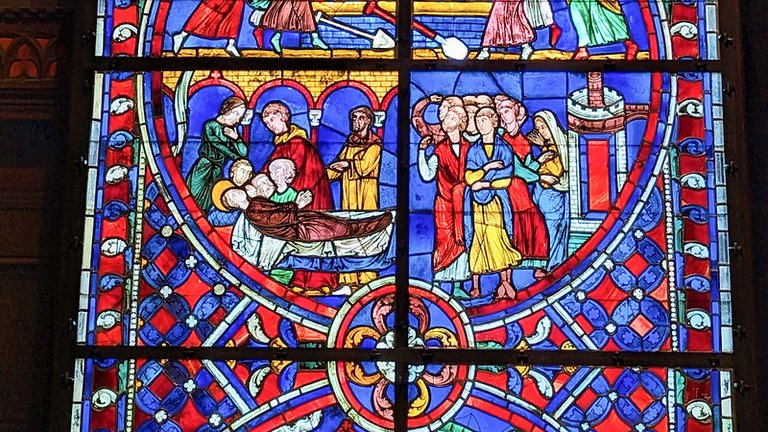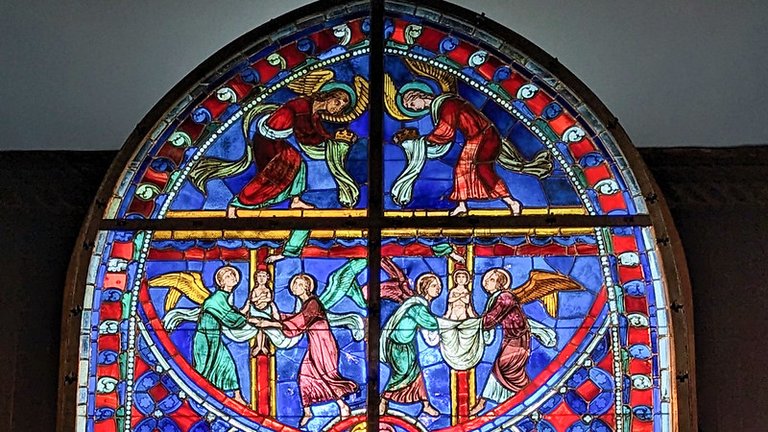Below is an essay I wrote for my Art History class at Cambridge. I chose this beautiful stained glass for one of the two essays I wrote about medieval art.
This remarkable 13th century French Gothic stained-glass lancet window from Soissons, France was installed in 1906 in the Isabella Stewart Gardner Museum in Boston, Massachusetts. [Figure 1] It has been praised by Professor Madeline Caviness, a renowned European medieval stained-glass expert, as "the finest example of early thirteenth-century French stained glass in America." Still in excellent condition, this twelve-foot lancet window retains about 60% of its original glass. It exemplifies the earliest period of stained glass with its incredible mosaic technique. The window’s dominant blues and reds are complemented by greens, yellows, and purples, and the characteristic ironwork cohesively connects and separates each panel.
This essay contrasts with the perspective of 19th-century English stained-glass artist, Hugh Arnold, who argues stained glass’s sole purpose is to beautify buildings. This essay challenges that notion, proposing that narrative medieval stained glass served a higher purpose to inspire Christian ideals through storytelling. Illuminated with light and color, these windows were visual narratives that encouraged viewers to draw inspiration to the people and stories depicted. This analysis will delve into three critical aspects of the Soissons Window: its storytelling, gestures, and iconography, all of which demonstrate its significance beyond mere aesthetic enhancement and decoration.
Created in 1205 AD, the window pictured portrays Nicasius and his sister, Eurtropia. Nicasius, the archbishop of Reims in the 5th century was martyred during the Vandals’ attack in 405 AD when he was beheaded. Fearing the loss of her virtue, Eutropia attacked her brother’s killer and became a martyr herself. Their story immortalized in glass, extends beyond the adoration of saints’ by demonstrating a devotion to God through sacrifice.
In the traditional manner of reading French stained glass from bottom to top, this lancet window, composed of ten sections, narrates a vivid story.
 Figure 1. Soissons Window, Boston, Mass. Photo S. Jarvie
Figure 1. Soissons Window, Boston, Mass. Photo S. Jarvie
Therefore, the window exemplifies Ashley Laverock’s observation about the 13th century rise in narrative stained-glass windows mirroring the growing devotion to the saints. Having explored the window’s overarching story this essay will discuss specific gestures to further develop the story’s meaning.
 Figure 3. Close up for panel #1, Soissons Window, Boston, Mass. Photo S. Jarvie
Figure 3. Close up for panel #1, Soissons Window, Boston, Mass. Photo S. Jarvie
Barbara Palmer notes the pivotal role of gestures is to express the characters’ inner psychology. This insight is particularly relevant in the Soissons window. One striking scene [Figure 2] juxtaposes the contradictory gestures of violence and submission in Eurtropia’s death. The intent of the armed man is easy to decipher; he is going to kill Eurtropia. The gestures of Eurtropia are slightly more nuanced; she is kneeling with her hands in prayer position. Kneeling is a common form of submission, but to the viewer it is not clear if she is submitting to her killer or to God. Therefore, the viewer must come to their own conclusions.
Another scene that can be confusing to viewers, is expressed in Figure 3 where the townspeople collectively look in one direction and one man has his hand raised to his brow. This gesture indicates interest and uncertainty. The townspeople may be looking into the next panel to the prone Eutropia. Another explanation, that was given by Caviness, is that the townspeople are greeting Nicasius or sighting the Barbarians. The latter seems more realistic as one man is also turned in a protective stance towards the woman standing next to him. His gesture is one of care and concern. Barbara Palmer argues, that gesture can express a person’s inner psychology but sometimes that is hard to discern. Such uncertainty enriches the narration and invites the viewer to ponder the meaning of these “silent” gestures.
Figure 3. Close up of panel, Soissons Window, Boston, Mass. Photo S. Jarvie
Another way to inspire Godly devotion is through iconography. The artists’ use of wings to signify angels along with crosses and halos to help the viewers understand this as a religious scene. The two iconographic representations this essay focuses on are the hand of God and the crowns the angels are holding. Medieval artists used the technique of showing a small part of God such as a hand or foot. In this stained-glass window, the hand of God is coming down through the blue clouds to bless the souls of Nicasius and Eurtropia. Similarly, the angels of God are presenting a crown for the saints, letting the viewers know the actions of Nicasius and Eurtropia are blessed by God and therefore to be emulated. [Figure 4]
Figure 4. Close up for panels, Soissons Window, Boston, Mass. Photo S. Jarvie
This essay examined the stained-glass window from the Soissons Cathedral which now resides in Boston at the Isabella Stewart Gardner Museum. This 13th century French window tells the story of siblings Nicasius and Eurtropia. In addition to the account of these 5th century martyrs, the gestures seen throughout the window enhance the complexity of the story. This beautiful Gothic stained-glass window is also full of religious iconography. Medieval narrative stained glass and the techniques discussed were used, maybe didactically, to shape the viewers experience and direct the viewer to contemplate Christian virtues and ideals. Therefore, this window effectively demonstrates its significance beyond its artistic enrichment.
Sources:
Arnold, Hugh. Stained Glass of the Middle Ages in England and France. CreateSpace Publishing, 2015.
Beaven, Marilyn and Caviness, Madeline and Pastan Elizabeth. “The Gothic Window from Soissions: A Reconsideration.” Fenway Court 1983, 1984.
Burrow, J. A. Gestures and Looks in Medieval Narrative. Cambridge Studies in Medieval Literature 48. Cambridge, UK ; New York: Cambridge University Press, 2002.
Laverock, Ashely. "Saints' Lives and Stained Glass" in Investigations in Medieval Stained Glass: Materials, Methods, and Expressions. Reading Medieval Sources, Volume 3. Leiden ; Boston: Brill, 2019.
Palmer, Barbara. Gestures of Greeting. Edited by Davidson, Clifford. Early Drama, Art, and Music Monograph Series 28. Kalamazoo, Mich: Medieval Institute Publications, Western Michigan University, 2001.

Art Talk Series Highlights
2024
Theme: Visual Analysis
Art Talk: Visual Analysis: Gol Stave Church and Yggdrasil
Art Talk: Visual Analysis of the Church of the Multiplication of the Loaves and Fishes
Art Talk: Visual Analysis of Laocoon
Art Talk: Visual analysis of a Greek Vase
Art Talk: 2023 Posts
Art Talk: 2022 Posts
Art Talk: 2021 Posts
Art Talk: 2020 Posts
Art Talk: 2019 Posts
Art Talk: 2018 Posts
Wow! You have managed to delve deeply into the Soissons stained glass windows, not only as works of art, but also as living and meaningful spiritual narratives. The discussion of gesture and iconography really adds an interesting psychological dimension, making us reflect on the sacrifice and piety immortalized in the glass. The work takes us on a journey back in time, where each panel tells a story, full of color and spiritual nuances. Very inspiring!❤
@seha76 I am so glad you liked the essay. I feel like it did take me back in time.
All this narrative contained within the stained glass is interesting. I think that in general, data, contained in books or historical documents of any kind, are contrasted with these representations, although there is always going to be subjectivity and that is the viewer's choice.
These stained glass windows are marvellous.
Thank you for sharing your essay.
Hi @nanixxx So glad you liked the essay. The window is amazing and it was fun to research it.
👌